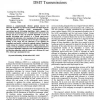575 search results - page 16 / 115 » Computing Maximum Subsequence in Parallel |
ICDCS
2006
IEEE
14 years 1 months ago
2006
IEEE
Earlier work has developed the underpinnings of a theory of scheduling computations having intertask dependencies—modeled via dags—for Internet-based computing. The goal of th...
IPPS
2006
IEEE
14 years 1 months ago
2006
IEEE
Inference of phylogenetic trees using the maximum likelihood (ML) method is NP-hard. Furthermore, the computation of the likelihood function for huge trees of more than 1,000 orga...
ICC
2007
IEEE
14 years 1 months ago
2007
IEEE
—A computationally efficient optimal discrete bit allocation algorithm is proposed for medium and high target bit rate discrete multitone (DMT) transmissions. Unlike conventional...
CCECE
2006
IEEE
14 years 1 months ago
2006
IEEE
Phylogenetic trees are commonly reconstructed based on hard optimization problems such as Maximum parsimony (MP) and Maximum likelihood (ML). Conventional MP heuristics for produc...
ALGORITHMICA
2006
13 years 7 months ago
2006
Phylogenetic analysis is an area of computational biology concerned with the reconstruction of evolutionary relationships between organisms, genes, and gene families. Maximum likel...


